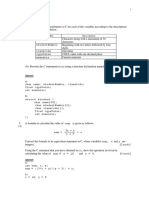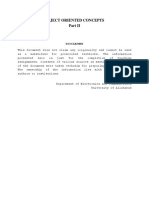0% found this document useful (0 votes)
3 views15 pagesChapter 2 Arrays and Strings
Chapter Two covers arrays and strings in programming, defining arrays as collections of identical data objects stored in consecutive memory locations. It explains properties, declaration, initialization, and accessing elements of arrays, emphasizing the importance of bounds and proper indexing. The chapter also introduces strings as arrays of characters, detailing their initialization and methods for assigning values using functions like strcpy.
Uploaded by
ewnetualemu2Copyright
© © All Rights Reserved
We take content rights seriously. If you suspect this is your content, claim it here.
Available Formats
Download as DOCX, PDF, TXT or read online on Scribd
0% found this document useful (0 votes)
3 views15 pagesChapter 2 Arrays and Strings
Chapter Two covers arrays and strings in programming, defining arrays as collections of identical data objects stored in consecutive memory locations. It explains properties, declaration, initialization, and accessing elements of arrays, emphasizing the importance of bounds and proper indexing. The chapter also introduces strings as arrays of characters, detailing their initialization and methods for assigning values using functions like strcpy.
Uploaded by
ewnetualemu2Copyright
© © All Rights Reserved
We take content rights seriously. If you suspect this is your content, claim it here.
Available Formats
Download as DOCX, PDF, TXT or read online on Scribd
/ 15




















































































